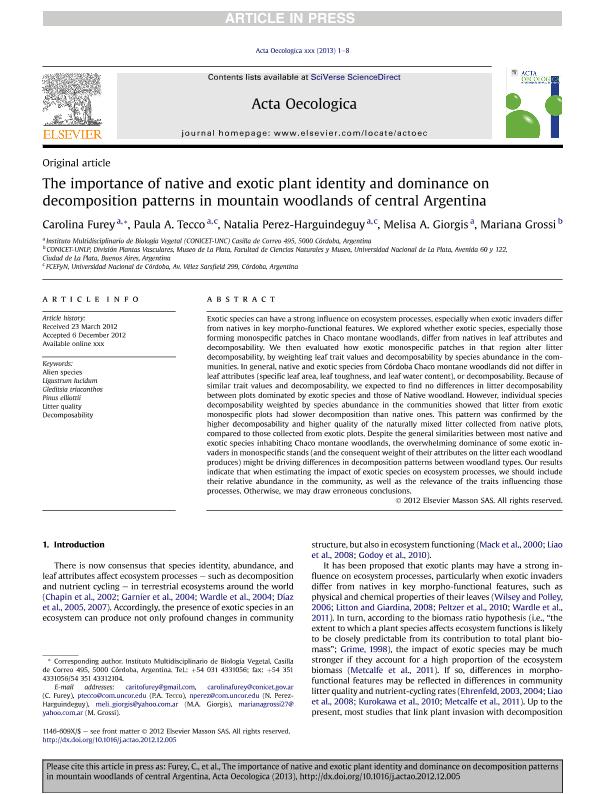Mostrar el registro sencillo del ítem
dc.contributor.author
Furey, Carolina

dc.contributor.author
Tecco, Paula Andrea

dc.contributor.author
Perez Harguindeguy, Natalia

dc.contributor.author
Giorgis, Melisa Adriana

dc.contributor.author
Grossi, Mariana Andrea

dc.date.available
2017-04-03T19:54:19Z
dc.date.issued
2012-11
dc.identifier.citation
Furey, Carolina; Tecco, Paula Andrea; Perez Harguindeguy, Natalia; Giorgis, Melisa Adriana; Grossi, Mariana Andrea; The importance of native and exotic plant identity and dominance on decomposition patterns in mountain woodlands of central Argentina; Elsevier Masson; Acta Oecologica; 54; 11-2012; 13-20
dc.identifier.issn
1146-609X
dc.identifier.uri
http://hdl.handle.net/11336/14730
dc.description.abstract
Exotic species can have a strong influence on ecosystem processes, especially when exotic invaders differ from natives in key morpho-functional features. We explored whether exotic species, especially those forming monospecific patches in Chaco montane woodlands, differ from natives in leaf attributes and decomposability. We then evaluated how exotic monospecific patches in that region alter litter decomposability, by weighting leaf trait values and decomposability by species abundance in the communities. In general, native and exotic species from Córdoba Chaco montane woodlands did not differ in leaf attributes (specific leaf area, leaf toughness, and leaf water content), or decomposability. Because of similar trait values and decomposability, we expected to find no differences in litter decomposability between plots dominated by exotic species and those of Native woodland. However, individual species decomposability weighted by species abundance in the communities showed that litter from exotic monospecific plots had slower decomposition than native ones. This pattern was confirmed by the higher decomposability and higher quality of the naturally mixed litter collected from native plots, compared to those collected from exotic plots. Despite the general similarities between most native and exotic species inhabiting Chaco montane woodlands, the overwhelming dominance of some exotic invaders in monospecific stands (and the consequent weight of their attributes on the litter each woodland produces) might be driving differences in decomposition patterns between woodland types. Our results indicate that when estimating the impact of exotic species on ecosystem processes, we should include their relative abundance in the community, as well as the relevance of the traits influencing those processes. Otherwise, we may draw erroneous conclusions.
dc.format
application/pdf
dc.language.iso
eng
dc.publisher
Elsevier Masson

dc.rights
info:eu-repo/semantics/openAccess
dc.rights.uri
https://creativecommons.org/licenses/by-nc-nd/2.5/ar/
dc.subject
ALIEN SPECIES
dc.subject
DECOMPOSABILITY
dc.subject
GLEDITSIA TRIACANTHOS
dc.subject
LIGUSTRUM LUCIDUM
dc.subject
LITTER QUALITY
dc.subject
PINUS ELLIOTTII
dc.subject.classification
Ecología

dc.subject.classification
Ciencias Biológicas

dc.subject.classification
CIENCIAS NATURALES Y EXACTAS

dc.title
The importance of native and exotic plant identity and dominance on decomposition patterns in mountain woodlands of central Argentina
dc.type
info:eu-repo/semantics/article
dc.type
info:ar-repo/semantics/artículo
dc.type
info:eu-repo/semantics/publishedVersion
dc.date.updated
2017-03-30T18:24:06Z
dc.journal.volume
54
dc.journal.pagination
13-20
dc.journal.pais
Francia

dc.journal.ciudad
Paris
dc.description.fil
Fil: Furey, Carolina. Consejo Nacional de Investigaciones Científicas y Técnicas. Centro Científico Tecnológico Conicet - Córdoba. Instituto Multidisciplinario de Biología Vegetal. Universidad Nacional de Córdoba. Facultad de Ciencias Exactas Físicas y Naturales. Instituto Multidisciplinario de Biología Vegetal; Argentina
dc.description.fil
Fil: Tecco, Paula Andrea. Consejo Nacional de Investigaciones Científicas y Técnicas. Centro Científico Tecnológico Conicet - Córdoba. Instituto Multidisciplinario de Biología Vegetal. Universidad Nacional de Córdoba. Facultad de Ciencias Exactas Físicas y Naturales. Instituto Multidisciplinario de Biología Vegetal; Argentina
dc.description.fil
Fil: Perez Harguindeguy, Natalia. Consejo Nacional de Investigaciones Científicas y Técnicas. Centro Científico Tecnológico Conicet - Córdoba. Instituto Multidisciplinario de Biología Vegetal. Universidad Nacional de Córdoba. Facultad de Ciencias Exactas Físicas y Naturales. Instituto Multidisciplinario de Biología Vegetal; Argentina
dc.description.fil
Fil: Giorgis, Melisa Adriana. Consejo Nacional de Investigaciones Científicas y Técnicas. Centro Científico Tecnológico Conicet - Córdoba. Instituto Multidisciplinario de Biología Vegetal. Universidad Nacional de Córdoba. Facultad de Ciencias Exactas Físicas y Naturales. Instituto Multidisciplinario de Biología Vegetal; Argentina
dc.description.fil
Fil: Grossi, Mariana Andrea. Consejo Nacional de Investigaciones Científicas y Técnicas. Centro Cientifico Tecnológico La Plata; Argentina. Universidad Nacional de La Plata. Facultad de Ciencias Naturales y Museo. División de Plantas Vasculares; Argentina
dc.journal.title
Acta Oecologica

dc.relation.alternativeid
info:eu-repo/semantics/altIdentifier/doi/http://dx.doi.org/10.1016/j.actao.2012.12.005
dc.relation.alternativeid
info:eu-repo/semantics/altIdentifier/url/http://www.sciencedirect.com/science/article/pii/S1146609X12001737
Archivos asociados
